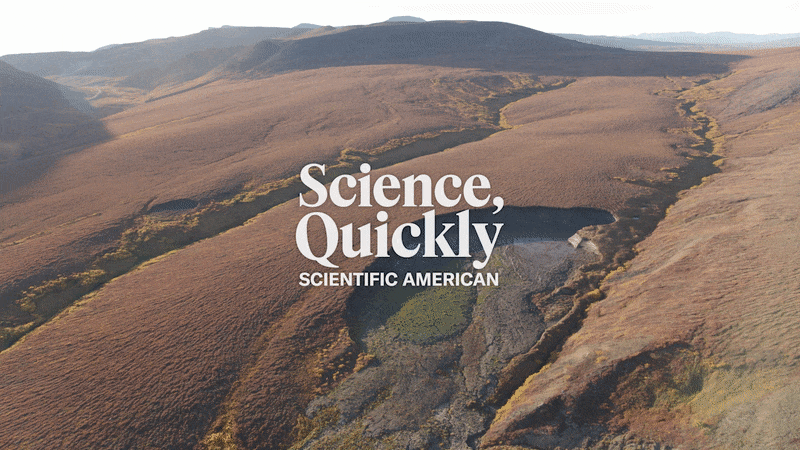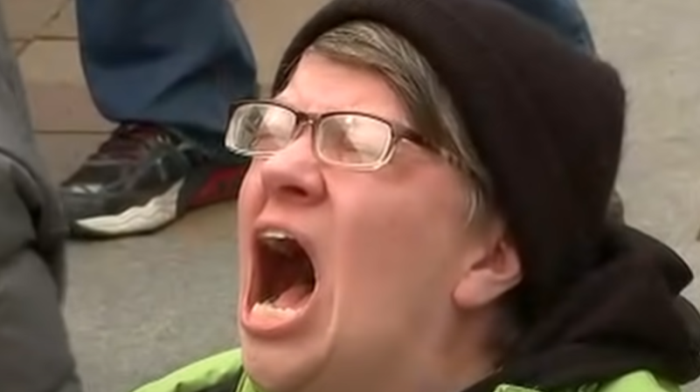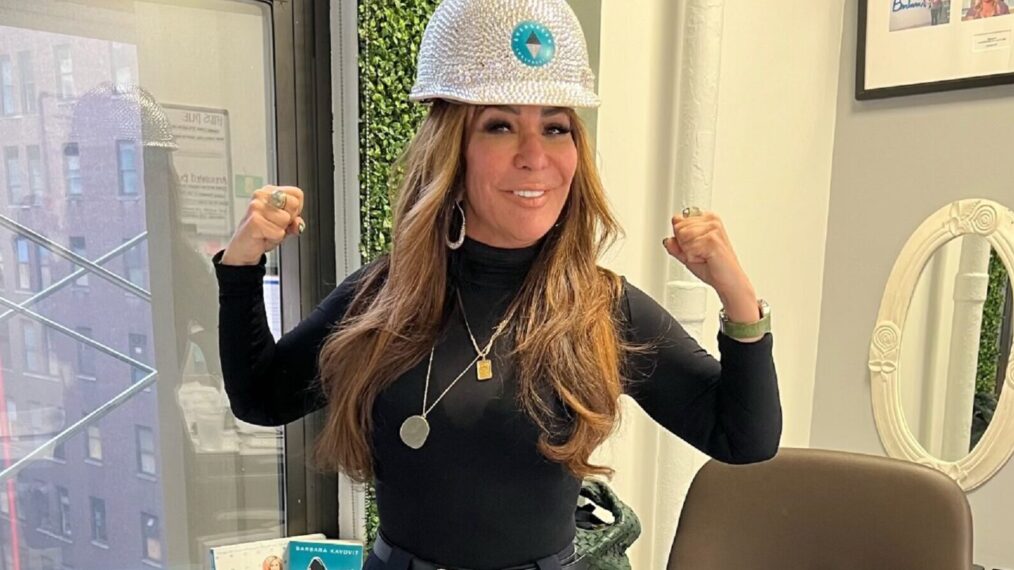
Joc Bentley: Are you okay?
Steve Kokelj: Yeah. No, I’m just looking around where everyone is. I have to do that once in a while. We had a bear almost walk into us the other day because we were, like, staring at a thaw slump. And we turn around, and we’re like, “Oh, that, that’d be a grizzly bear there.”
Bentley: That’s Steve Kokelj. And the reason he has to be on the lookout for grizzlies has everything to do with where we’re standing right now.
Kokelj: We’re, uh, we’re in the Northwest Territories.
Bentley: That’s the Northwest Territories in the high Canadian Arctic.
Hey, I’m Joc Bentley, and I’m out here just north of the Arctic Circle to take you on a journey to the thawing edge of climate change.
Over the next three episodes of Science, Quickly, we’ll be mucking around in a part of the world that is warming faster than just about any other.
Just a few years ago the tundra here was frozen solid, and now there’s a massive hole with an area the size of more than nine football fields—and growing. The ground is disappearing under our feet. I’m trying not to get too close because there’s a 20-meter drop-off.
And I’m gonna say meters because I’m Canadian. Just getting that out of the way.
This used to be a landscape shaped by ice. Now it’s being completely transformed.
[CLIP: Show music]
Bentley: But let’s get back to Steve. He’s here to study that now not-so-perma permafrost.
Kokelj: We’re on the Peel Plateau.
Bentley: Steve works for the Northwest Territories Geological Survey. He has a constant entourage of students, and he’s wearing an amazing Canadian lumberjack uniform.
Kokelj: Behind me is a type of permafrost landslide called a retrogressive thaw slump. That’s a type of permafrost landslide that forms in areas where the permafrost contains a lot of ice.
Bentley: That thaw slump he’s talking about? That’s the hole. To picture it, you have to imagine what it would look like if a massive mound of earth just sorta turned into molasses one day and started flowing downhill.
And the land that became molasses is really old.
Kokelj: So the ice that’s melting behind us is a leftover of the, of the glaciation that covered most of Canada, and it’s somewhere around [16,000] to 13,000 years old.
Bentley (tape): Does this mean we’re still in an ice age?
Kokelj: We are. We are still in an ice age. And the process of deglaciation, which is when the ice goes away, in the North, it hasn’t ended yet. So we’re still going through a period of deep glaciation here.
Bentley: This always blows my mind. We’re still in an ice age. And that means Earth has a lot of room to get even hotter. Canada is seeing some of the fastest warming on the planet. And Steve says that has huge implications, especially for our frozen ground.
Kokelj: Most people don’t, may not appreciate this, but half of Canada is affected by permafrost, right? So it’s the northern half. But now that everything’s changing, it’s becoming a really, really important discipline to understand and improve the resilience of the Canadian North but also to understand global change issues related to the carbon being released from permafrost.
Bentley: Half of Canada. That’s almost too large an area to really comprehend. And even when you’re standing next to a thaw slump, it can still be tough to appreciate how big the changes are here.
So we got in a chopper for a bird’s-eye view. Keellie Stachniak, our pilot, took us for a tour of nearby slumps. So hold on and listen close because it’s about to get real noisy.
[CLIP: Helicopter taking off ambience]
Stachniak: Should I take them to a slump?
Kokelj: Yeah, same one as yesterday.
Right beneath us, this debris tongue, it has infilled the whole valley, and it has accumulated about 35 meters.
Bentley: And just to put that into perspective, that’s as high as a 10-story building.
Kokelj: Yeah, a lot of these streams were clearwater streams before, right? The thaw slumps are releasing all these sediments, and they’re just changed, and they will be from now …
Keellie: Forever?
Kokelj: For the foreseeable future, yeah.
The materials that are coming out of the permafrost, it’s not so much their makeup, it’s the volume that are being put into the river systems here that are detrimental to the ecosystems.
Bentley: And Steve says this is just the beginning.
Kokelj: As the climate is warming and as summers are getting wetter, these types of disturbances are getting bigger. And in the past, under colder conditions, a thaw slump would grow over a period of a number of years and then stabilize. But as the climate’s warming, they continue to grow and impact larger areas of land.
Bentley: This isn’t just about land. There are Indigenous communities here that have been living off of this land for thousands of years. What’s going to happen to them?
Kokelj: So the people that live here are the Gwich’in people, and they’re very concerned about their landscape. They’re concerned about the water in their lakes and streams. They’re the people that have traditionally lived off of fish and caribou, of course. These types of disturbances, these types of landslides, deliver lots of sediment and other materials that have been locked into the permafrost into the streams, and that can affect the habitat in the streams and, and the health of the stream ecosystems.
Bentley: And the streams don’t only get filled with sediment. Steve and his team have seen entire lakes disappear. Both the Gwich’in and the Inuvialuit populations are facing some massive challenges.
In order to better predict what exactly is going to happen to permafrost on a warming planet, Steve’s team is running all kinds of experiments.
On the team, permafrost scientist Alice Wilson is trying to figure out if snow cover slows permafrost thaw. In the darkness of the freezing arctic winter, she manipulates the amount of snow on different areas of tundra. Then, when summer arrives, they check how much of the top layer of permafrost has melted.
Wilson: Alright, so what we’re doing right now is active layer, or thaw depth, measurements. So we use this graduated probe, where we have markings every 10 centimeters. So if we push it into the ground where we hit the bottom, you can kind of hear it sometimes. That’s the base of, at this time of year, the active layer and shows you where the frozen front is, or permafrost.
Bentley: And then Alice does these kinds of measurements again but in a different area with the same setup.
Wilson: And so we can measure this to see how deep it is to permafrost in different areas. And then the other thing I can pull out is this. So this is a thermosphere chain, and so it has a logger on top recording all the information. And then each of these has a temperature sensor. So we know the temperatures over time at different depths.
Bentley: Alice drops the line down a PVC tube running deep beneath our feet.
Wilson: So this would be half a meter, one meter, meter and a half, two. And this one goes all the way down to three meters below the ground and into the permafrost.
Bentley: The researchers are hoping all of these data will help to better predict what exactly is going to happen to the North in the decades to come. Steve is a big believer in the importance of the research performed by his entire team.
Kokelj: We just haven’t built our infrastructure, considering all these things, right? So it’s kind of one of the important reasons to just study things, because if you don’t make these observations, you can’t kind of adapt your infrastructure to deal with this kind of stuff. Yeah, a lot of the challenges can’t be overcome unless you do basic science, right?
Bentley: Science, Quickly is produced by Jeffery DelViscio, Tulika Bose and Kelso Harper. Our music was composed by Dominic Smith. Like and subscribe wherever you get your podcasts. And for more science news, please go to ScientificAmerican.com.
For Science, Quickly, I’m Joc Bentley.
Funding for this story was provided in part by Let’s Talk Science, a charitable organization that has provided engaging, evidence-based STEM programs for 30 years at no cost for Canadian youth and educators.


























































